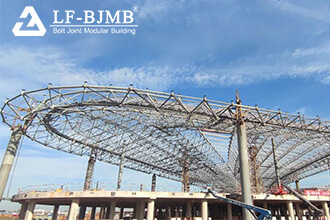+86 177 5193 6871
222, Block B, Diamond International, Guozhuang Road, Xuzhou, Jiangsu, China

A steel terminal building is an air terminal building that uses steel as the main structural material. Compared to traditional concrete structures, steel terminals have some unique features and advantages:

Fast construction: Steel structures can be fabricated and erected relatively quickly, which helps to shorten the construction cycle. Because structural steel components can be prefabricated in the factory, on-site construction time is reduced and construction efficiency is increased.
Flexible design: Steel structures can be more easily customised in shape and structure, giving designers more flexibility to create unique building forms. This is especially important for buildings such as terminals, where flight safety and passenger mobility are important considerations.
Sustainability: Steel is a recyclable material, so steel-framed terminals contribute to sustainable building goals. In addition, steel structures help reduce energy consumption as they provide greater natural light and ventilation.
Adaptable: A steel terminal building is highly adaptable to a wide range of climatic and geological conditions. This makes it possible to build and maintain structural stability and safety in different regions and environments.
Ease of Maintenance: Steel structures are relatively easy to maintain and repair, as damaged sections can be replaced or repaired relatively easily without undue impact on the overall structure.
It is important to note that despite these advantages of steel-framed terminals, a variety of factors need to be taken into account during the design and construction process, including the building’s purpose, environmental requirements, and cost.
